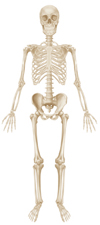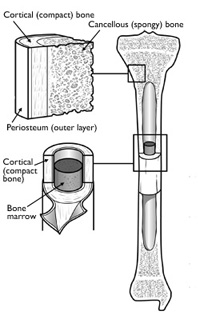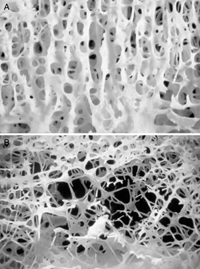
Bone Health Basics
Bones. They give our bodies structure, allowing us to walk, ride a bike, and hold a child. They protect our organs and store our supply of calcium, a mineral necessary for building and maintaining strong bones.
In the last 15 years, we have learned a great deal about bones — the way they work, grow, rebuild, weaken, and break. We now know that diet and exercise can grow strong healthy bones in children, and help maintain them as we age.
Most importantly, we have learned more about bone metabolism — which is how bone rebuilds itself and stays healthy throughout our lives. We have learned that some people are at higher risk for osteoporosis because their bone metabolism does not support sufficient rebuilding of bone. A healthy diet and exercise can help, but cannot solve this problem. However, doctors can now identify people at risk and provide treatments to correct problems with bone metabolism.
 Normal skeletal anatomy
Reproduced with permission from JF Sarwark, ed: Essentials of Musculoskeletal Care, ed 4.Rosemont, IL, American Academy of Orthopaedic Surgeons, 2010.
Normal skeletal anatomy
Reproduced with permission from JF Sarwark, ed: Essentials of Musculoskeletal Care, ed 4.Rosemont, IL, American Academy of Orthopaedic Surgeons, 2010.
What we have learned about bone health is especially important as Americans are living longer. By 2020, half of all Americans over age 50 will have weak bones, according to the National Institutes of Health (NIH). We can improve this outcome by making changes to our diet and lifestyle, and preventing bone loss in people who are most at risk.
The good news is, no matter what your age, there are many things you can do to improve your bone health.
Bone BasicsImportance of Bones
Bones and the skeleton play many important roles in the body. They:
- Store and supply calcium as needed for all of the cells and organs of the body
- Give our bodies support and muscle attachments which allow us to move and use our limbs
- Enclose and protect our vital organs
- Provide space for bone marrow, where all types of blood and bone cells are made
 In general, bones are made up of spongy, mesh-like cancellous bone covered by hard, compact cortical bone. At the center of many bones is soft bone marrow.
Reproduced with permission from JF Sarwark, ed: Essentials of Musculoskeletal Care, ed 4. Rosemont, IL, American Academy of Orthopaedic Surgeons, 2010.
In general, bones are made up of spongy, mesh-like cancellous bone covered by hard, compact cortical bone. At the center of many bones is soft bone marrow.
Reproduced with permission from JF Sarwark, ed: Essentials of Musculoskeletal Care, ed 4. Rosemont, IL, American Academy of Orthopaedic Surgeons, 2010.
In addition, bone cells respond to their environment to strengthen the structure of individual bones to resist fracture.
These complex functions occur within what appears to be a solid structure. And yet, while the outside of a bone looks like a rock, the inside more closely resembles lacy coral surrounded by a hard thick shell. Unlike a rock, a bone is living tissue that is constantly changing.
Bone Remodeling
After the body's skeleton forms and grows to its adult size, it completely regenerates itself about every 10 years, through a process called remodeling. Remodeling removes old pieces of bone and replaces them with new, fresh bone. This keeps the bone and its cells healthy and strong, and allows the bones to supply calcium to the body.
Keeping the skeleton in good repair requires a balance between the removal and replacement of bone tissue. In young healthy adults, the amount of bone removed and replaced is about the same. This is called balanced bone remodeling and is controlled by your bone metabolism. As we age, the remodeling process may shift out of balance, resulting in loss of bone structure and strength, and lead to bone disease, such as osteoporosis.
 Enlarged photographs of the cancellous bone inside a vertebral bone in the spine. (Top) Healthy cancellous bone. (Bottom) Cancellous bone loss caused by osteoporosis. This weakened bone is at an increased risk for fracture.
Reproduced from Einhorn TA: The structural properties of normal and osteoporotic bone. Instr Course Lect 2003; 52: 533-539.
Nutrition and Bone Health
Enlarged photographs of the cancellous bone inside a vertebral bone in the spine. (Top) Healthy cancellous bone. (Bottom) Cancellous bone loss caused by osteoporosis. This weakened bone is at an increased risk for fracture.
Reproduced from Einhorn TA: The structural properties of normal and osteoporotic bone. Instr Course Lect 2003; 52: 533-539.
Nutrition and Bone Health
.jpg) Good sources of calcium include milk, cheeses, leafy green vegetables, and almonds.
© Thinkstock, 2012
Good sources of calcium include milk, cheeses, leafy green vegetables, and almonds.
© Thinkstock, 2012
Good nutrition is essential to ensuring that the body has the protein, minerals, and vitamins needed to make and regenerate bone.
Calcium, phosphorus, zinc, and magnesium are necessary minerals that must come from our diets. Vitamins D, K, and A are needed for normal bone metabolism. Without these nutrients, our bones can become weak and more likely to break.
Calcium and Vitamin D are well known for the important role they play in building strong bones. The skeleton is our body's major storage bank for calcium, and Vitamin D helps our bodies effectively absorb calcium from our diets.
If we do not have enough calcium in our diets, calcium is removed from the skeleton, causing our bones to become weaker. Osteoporosis, the most common bone disease, can be worsened by a loss of calcium and other minerals.
Great sources of calcium are dairy products like yogurt and cheese, as well as cereals, soy products, and green leafy vegetables. Calcium supplements can also help if you generally avoid dairy products.
Physical Activity and Bone HealthBeing active and following a regular exercise program are important to maintaining healthy bones. Weight-bearing exercise is especially important for maintaining bone strength and preventing osteoporosis.
Weight-bearing physical activity can slow bone loss in older people. Maintaining muscle mass also preserves and strengthens surrounding bone and helps prevent falls. Weight-bearing describes any activity you do on your feet that works your bones and muscles against gravity. Regular weight-bearing exercises — such as brisk walking, jogging, or team sports — turns on your body's bone-forming cells and helps bones become stronger.
Maintaining Bone Health as You AgeAs we age, our bones are affected by genetics, nutrition, exercise, and hormonal loss. We cannot change our genes but we can control our nutrition and activity level, and if necessary, take osteoporosis medications. You are never too old or too young to improve your bone health.
Bone can definitely get stronger or weaker over time depending on how we take care of it.
Tips for Healthy Bones
Each year, approximately 1.5 million older Americans suffer fractures because of weak bones, leading to temporary or permanent disability, and even death.
There are things you can do to maintain and even improve your bone strength.
- Understand your individual risk for fracture. This is based on any risk factors you have for fracture and your bone density. Ask your doctor if you need a bone density test.
- Understand your individual risk for bone loss. Genetics plays a role in bone health, and some people have genetically determined high rates of bone turnover after menopause or with aging. Talk to your doctor about bone metabolism testing. Bone metabolism testing can provide additional information about your risk for fracture.
- Be active every day. Strength-building and weight-bearing activities help build strong bones. Children should exercise at least an hour each day, and adults should total 30 minutes of daily activity.
- Maintain a healthy weight. Older adults who are overweight have a higher risk for falling. Being underweight raises the risk of bone loss.
- Get enough calcium and Vitamin D.
- Do not smoke. Smoking can reduce bone mass and increase your risk for a broken bone.
- Limit alcohol use. Heavy alcohol use reduces bone mass and increases your risk for broken bones.
- Reduce your risk of falling. There are many changes your can make in your home to help prevent a fall. Remove obstacles and add safety features — such as grab bars and non-slip mats — where needed.
- Consider bone-boosting medications. In addition to calcium and Vitamin D supplements, there are many drug options that slow bone loss and increase bone strength. Talk to your doctor about these methods for protecting your bones.
Source: http://orthoinfo.aaos.org/topic.cfm?topic=A00578
